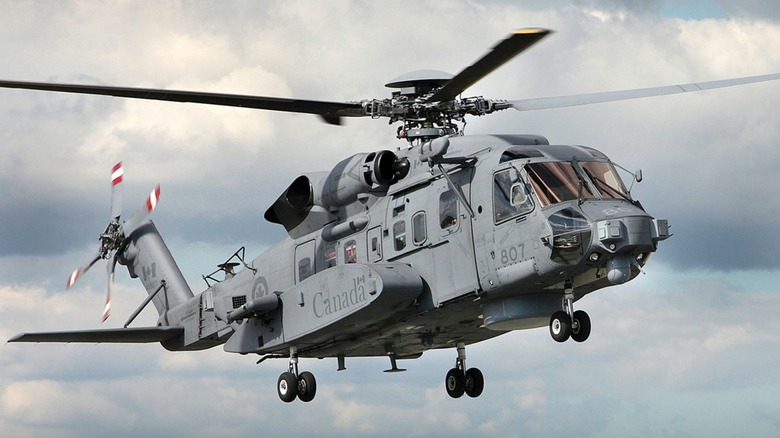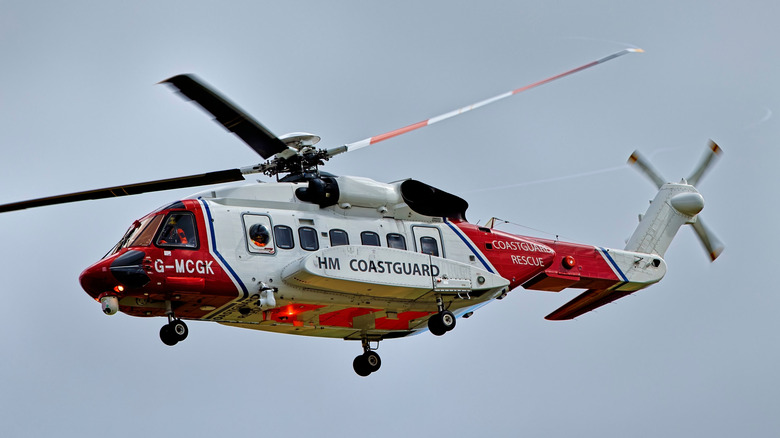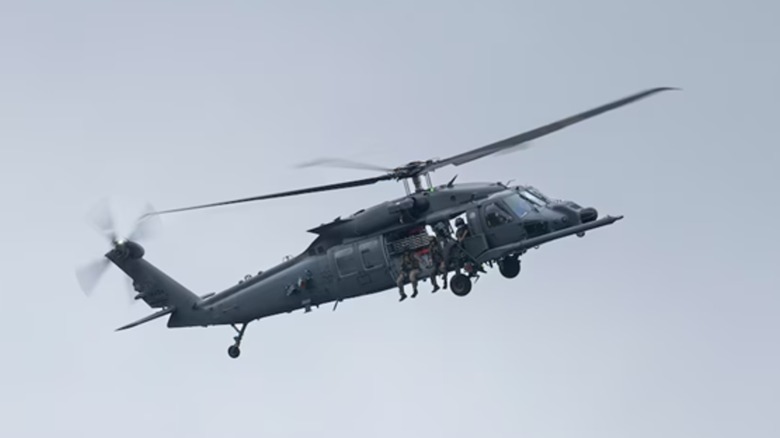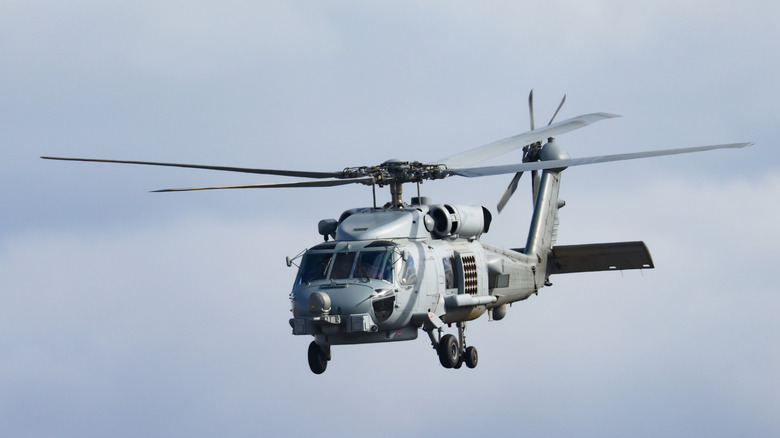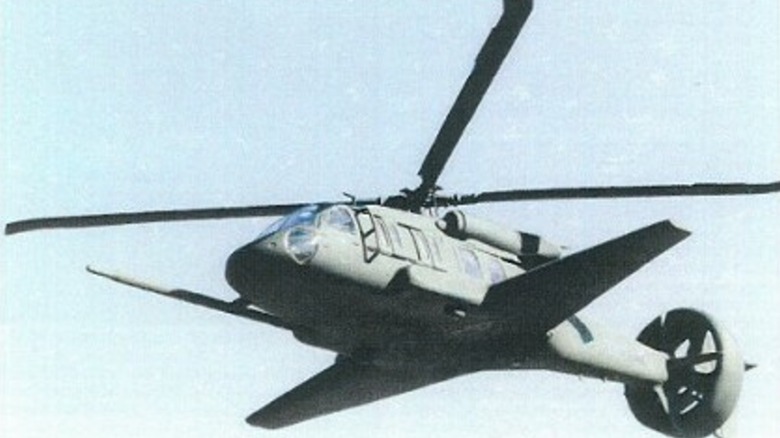Here's Every Military Helicopter Sikorsky Makes
What does it take to build a military vehicle? A company must prove it can manufacture machines that get the job done, keep their occupants safe, and most important of all, cost less than similar proposals. After all, the cheaper the vehicle, the more the military can buy. It goes without saying that once a company builds one military vehicle, it tends to build more.
The name Lockheed Martin is virtually synonymous with aircraft, particularly in the military sector. The company manufactures several iconic fighter jets, including the F-35 Lightning II and the F-22 Raptor, but Lockheed Martin also supplies the U.S. military with quite a few famous helicopters. Technically, it would be more accurate to say that Lockheed Martin's subsidiary, Sikorsky Aircraft, builds those vehicles. Sikorsky primarily deals in rotorcraft, i.e., helicopters. While the company sells several models to the general public, it also offers a sizable variety of military helicopters. These range from search and rescue choppers to what most people consider the modern de facto definition of a military helicopter. Here are some of the military helicopters Sikorsky puts into the sky.
UH-60 Black Hawk
Every so often, a vehicle comes along that becomes the example most minds jump to when they hear certain terms. For instance, many people think of the Boeing 747, also known as "The Queen of the Skies," the quintessential passenger jet. The same can be said for Sikorsky's premier product, the legendary UH-60 Black Hawk helicopter.
Whereas many helicopters (and military aircraft in general) are built with specific missions in mind, the Black Hawk is designed for versatility. You name a task, and a Black Hawk helicopter is likely a good candidate to pull it off. From search-and-rescue to reconnaissance to resupply to assault, the Black Hawk can do it all. Well, almost.
While the UH-60 Black Hawk can perform a wide variety of tasks, Sikorsky produces a catalog's worth of variant models. Some are as straightforward as a punch to the face, like the Armed Black Hawk – a Black Hawk helicopter carrying a small arsenal's worth of weapons and ammo. Others focus on specific traits and work on new components to transform into a completely different helicopter. The HH-60G Pave Hawk is one such chopper, as it takes the Black Hawk and turns it into a personnel recovery beast using the titular PAVE electronic system. While some Black Hawk variants have been retired, the Black Hawk family as a whole is alive and kicking.
CH-148 Cyclone
Most Sikorsky helicopters are built with the United States military in mind. However, Sikorsky has customers outside of the U.S. One of these buyers is the United States' neighbor to the north, and its military relies on Sikorsky for many maritime missions.
The CH-148 Cyclone is one of Canada's workhorse naval helicopters. This vehicle is a fly-by-wire variant (its manual controls have been replaced by an electronic interface) of Sikorsky's S-92 helicopter. Whereas the S-92 is primarily used for search-and-rescue and offshore energy transportation operations, the CH-148 performs surveillance, reconnaissance, and anti-submarine warfare roles.
Sikorsky added quite a few features to aid the CH-148 Cyclone in its ship-based environment. One such customization includes a folding tail and rotors to help the helicopter store comfortably within Halifax-class multi-role frigates of the Royal Canadian Navy. When fully folded, these articulated armatures shave a full 8 feet off the vehicle's length. The Cyclone's second key component is its mission system, which provides a live map that charts the topography of nearby waters both above and below the surface. General Dynamics supplied the map technology, but that isn't a knock against Sikorsky, as that company also supplies aviation and aviation-adjacent technology to other manufacturers, some of which we will cover later in this article.
H-92 Superhawk
As we just reviewed, the CH-148 Cyclone is a variant of the Sikorsky S-92 helicopter. However, that wasn't the only time Sikorsky retrofitted a civilian transport helicopter for military applications. Engineers squeeze every ounce of success out of their designs, resulting in multiple variants of a single core helicopter.
While the CH-148 Cyclone is based on Sikorsky's S-92 helicopter, the H-92 Superhawk is a straight-up military version of the S-92 — military brass didn't even bother issuing a new classification number. As the S-92 is primarily used for transportation, the H-92 likewise is primarily a tactical troop transporter. However, engineers can also configure the Superhawk to conduct search and rescue and anti-submarine warfare missions.
One may assume that the H-92 Superhawk could outperform the S-92, but that isn't the case. The H-92 Superhawk uses the same fly-by-wire control scheme as the CH-148 and works in radar warning and countermeasure systems. According to the vehicle's brochure, it's on par with the S-92 in cruising speed, range, service ceiling, and takeoff weight. However, the H-92 can carry more passengers, 22 against the S-92's 19-passenger limit, and those 22 passengers happen to be combat personnel with gear. As one might expect, the Superhawk includes weapon mounts. Pound for pound, the H-92 Superhawk holds its own as an upgunned combat variant of the S-92.
HH-60W Jolly Green II
Militaries often use vehicles and equipment for as long as possible. For instance, the HH-60 Pave Hawk is one of the oldest helicopters still used by the United States military. Even though it isn't the oldest rotorcraft sitting in U.S. hangars, it is getting long in the tooth, so it's easy to understand why the U.S. military is trying to replace this ancient workhorse.
The HH-60W helicopter is a rotorcraft with many names. The vehicle is known by the nicknames "Whiskey" and "Jolly Green II," but it is probably best recognized as the successor to the HH-60 Pave Hawk. Like the Pave Hawk, the HH-60W Jolly Green II is designed primarily for combat rescue missions but retains the Black Hawk's versatility.
In many respects, the Jolly Green II can be described as a badder and better version of the Pave Hawk without necessarily being bigger. The HH-60W boasts an impressive weapon and sensor suite, and most importantly, doubles the fuel capacity without resorting to auxiliary fuel tanks. Of course, as the Jolly Green II is essentially the Pave Hawk 2.0, the upgraded helicopter includes a digital radar warning receiver, tactical moving map displays, and improved communications systems. The exhausts are even designed to mask infrared signatures, because the last thing any rescue helicopter crew wants is a homing missile locked onto their vehicle.
MH-60R Seahawk
While the Black Hawk became the groundwork for countless helicopters (many of which are in this article), these variants didn't stray too far from their origins. However, there's always an exception to the rule, especially when a variant is designed to fly over a specific landscape.
As you can probably guess, the MH-60R Seahawk is a naval variant of the ever-reliable Black Hawk design. The Seahawk is designed to prey on submarines and enemy surface ships, and like any good predator, this helicopter is packed to the gills with advanced hunting sensors. The MH-60R has multi-mode radar, electro-optical and infrared cameras, and dipping sonars and sonobuoys. Of course, each Seahawk has several weapons to engage in anti-ship and submarine warfare, including torpedoes. Seahawks can also be further modified to carry out different missions. One variant is the MH-60S Knighthawk, which is designated for search-and-rescue missions, as well as mine countermeasure jobs.
Sikorsky has plans to keep MH-60R Seahawks operational until at least 2045, but you know what they say about the best laid plans of mice and men. The United States Navy recently unveiled its intention to replace MH-60R Seahawks with the V-280 VTOL aircraft.
CH-53K King Stallion
While the different branches of the U.S. military still use several old helicopters, all active choppers are, in actuality, the latest models of long-running product lines. The technology has improved, but the names and designations stay the same. Mostly.
The CH-53K King Stallion is the largest military helicopter in the U.S. military and is considered a heavy-lift helicopter. This colossal chopper can lift 27,000 pounds of cargo, which is enough to carry up to two heavily armored HMMWVs (Humvees) or Light Armored Vehicle variants at a time. However, this impressive feat is still a far cry from the current heavyweight lifting champion, the Mi-26. This literal helicarrier can ferry a staggering 44,000 pounds of weight. However, records aren't everything.
While the Mil Mi-26 has the CH-53K beat in terms of sheer lifting power, the King Stallion has the edge in ease of use. Like many modern Sikorsky helicopters, the King Stallion uses fly-by-wire controls, which are not only safer but also more precise than manual controls. Lockheed Martin boasts that the CH-53K can "precision hover in 40-knot (74 km) wind gusts," a feat that no other heavy hauler helicopter can accomplish. The U.S. Navy frequently uses the CH-53K King Stallion to run supplies from ship to shore (and vice versa) and support amphibious and shoreline operations.
SB-1 Defiant
Manufacturing vehicles for the military isn't always building combat-ready tanks and airplanes. Existing vehicles serve as a testbed for experimental technologies for months or years before deploying an all-new vehicle.
The SB-1 Defiant is a prototype aircraft that runs on Sikorsky's X2 technology. Instead of having two rotors, the SB-1 and, by extension, all X2-driven helicopters have three. Two are situated on top of the main coaxial system and rotate counter to one another, and a third sits perpendicular to the tail like a submarine's propeller. As a result, the SB-1 looks less like a proper military helicopter and more like a fictional toy helicopter a la "G.I. Joe" or "M.A.S.K." But maybe the toy designers were onto something.
According to Sikorsky, the SB-1 Defiant can fly fast and low, evade enemy fire, and navigate complex terrain. The Defiant outpaces the Black Hawk helicopter, which claims a max cruise speed of 167 mph, and doubles its range of approximately 950 miles. Yet despite the stark contrast in performance, the SB-1 and Black Hawk share mission profiles. The Black Hawk helicopter has a long-lived and reliable legacy, but the SB-1 Defiant might actually dethrone Sikorsky's current king of the skies.
S-97 Raider
As Sikorsky's X2 technology is proprietary, the company is free to use it as it pleases, and it turns out that Sikorsky's engineers have more than one design utilizing X2 rotors in the pipeline. The S-97 Raider is another prototype helicopter powered by X2 rotors.
Whereas the Defiant is classified as a "utility helicopter" that is designed to get in, drop off soldiers (or pick them up), and get out as fast as possible, the S-97 is more of a reconnaissance vehicle. The experimental aircraft leverages the same technology to remain nimble for the intent of scouting out targets. Of course, like any good military vehicle, Sikorsky has left the S-97's design open and modifiable, so it can also conduct light assault, search and rescue, and air support missions.
While the X2 technology renders the S-97 Raider (and by extension the SB-1 Defiant) faster and more agile than other military helicopters, the vehicle's rotor system has several tricks up its sleeve. Pilots can turn off the helicopter's rear rotor/propeller to engage 'Whisper Mode', which lets it sneak up on potential targets, and also pull the rear rotor into reverse to slow descent. Moreover, the S-97 Raider can execute a nose-down hover, which is exactly what it sounds like and impossible in other helicopter rotor designs. These features are accredited to the X2's unique three-rotor layout, so we can probably expect other applications of Sikorsky's technology that use it to pull off the same feats.
Raider X
Normally, one might expect prototype helicopter designs to either turn into mass-produced models or be abandoned altogether. However, sometimes prototypes give way to even more prototypes, especially when they use technology like the X2 rotor system.
Sikorsky's Raider X is the latest helicopter to use X2 technology. And, as its name suggests, the Raider X is a follow-up to the S-97 Raider. Whereas the S-97 features a 34-foot rotor diameter, the Raider X boasts a 39-foot rotor diameter. This upscaled design is meant to accommodate a new motor. Even though the Raider X and S-92 Raider are technically separate, standalone vehicles, Vertical reported Sikorsky's description of the Raider X testbed as "an 80-percent scale model" of the Raider X.
Judging by Sikorsky/Lockheed Martin's page describing the Raider X, the companies are going all in on this project to make it versatile and long-lasting. According to the website, the Raider X is designed via digital programs that will reduce production costs and make it easy to upgrade rapidly. The Raider X is designed with sustainability in mind, as it will include self-monitoring programs that cut down on maintenance cost and time. Instead of rotating Raider X helicopters out of active duty for maintenance, the vehicle will tell crewmembers when it needs a tune-up or repair. Add in a modular plug-and-play system designed to accept a wide variety of weapons, and it sounds like Sikorsky is trying to make the Raider X the next Black Hawk.
X-49 Speedhawk and Gen 2 Turret
Recently, we published an article on Sikorsky's MATRIX technology, which gives helicopters self-flying capabilities. While the project is a collaboration between Sikorsky and DARPA, MATRIX has only so far been installed in one of Sikorsky's own UH-60 Black Hawk helicopters. But this is not Sikorsky's only cross-company venture.
At first glance, one might confuse the Piasecki X-49 Speedhawk for a helicopter using X2 technology. Not only is it one of the strangest military helicopters ever made, but it also sports a rear rotor that sits perpendicular to the tail. However, instead of housing two counter-rotating rotors at the top, the Speedhawk uses only one set of main rotors and features two small wings on the side of the main fuselage. This isn't a case of plagiarism, and not just because the Speedhawk predates the X2 system. Piasecki manufactures the X-49 Speedhawk using the body frame of a Sikorsky SH-60 Seahawk, figuratively and literally relying on Sikorsky to make the X-49 Speedhawk a reality.
The MATRIX isn't the only system Sikorsky has developed for helicopters. The company also produced the Gen 2 Turret, alternatively known as the M-Turret (which stands for Modernized Turret). This component is designed to replace the aging Target Acquisition Designation Sight (TADS) system on Boeing's AH-64 Apache — a military helicopter going on 41 years old. The Gen 2 Turret is supposedly more reliable than the TADS in combat situations, and it is estimated to save the U.S. Army over $500 million in operation and support costs.
